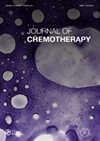针对铜绿假单胞菌的pqsr特异性群体感应抑制剂:目前进展和未来方向。
IF 1.8
4区 医学
Q3 INFECTIOUS DISEASES
引用次数: 0
摘要
多药耐药(MDR)铜绿假单胞菌的出现是由多种耐药机制驱动的,包括群体感应(QS)和生物膜形成。QS调节毒力、抗生素耐受性、外排泵和生物膜发育,增强病原体的适应性。在QS系统中,喹诺酮假单胞菌信号调节因子(PqsR)在控制毒力和生物膜相关基因中起核心作用。这篇综述对PqsR调控的网络进行了批判性的研究,并强调了PqsR抑制剂降低致病性的潜力。破坏QS而不是靶向细菌活力可以提高抗生素疗效,使这种组合方法成为对抗耐多药铜绿假单胞菌的有希望的策略。本文章由计算机程序翻译,如有差异,请以英文原文为准。
PqsR-specific quorum sensing inhibitors targeting Pseudomonas aeruginosa: current advances and future directions.
The emergence of multidrug-resistant (MDR) Pseudomonas aeruginosa is driven by diverse resistance mechanisms, including quorum sensing (QS) and biofilm formation. QS regulates virulence, antibiotic tolerance, efflux pumps, and biofilm development, enhancing the pathogen's adaptability. Among QS systems, the Pseudomonas quinolone signal regulator (PqsR) plays a central role in controlling virulence and biofilm-associated genes. This review critically examines the PqsR-regulated network and highlights the potential of PqsR inhibitors to reduce pathogenicity. Disrupting QS instead of targeting bacterial viability can enhance antibiotic efficacy, making this combinatorial approach a promising strategy to combat MDR P. aeruginosa.
求助全文
通过发布文献求助,成功后即可免费获取论文全文。
去求助
来源期刊

Journal of Chemotherapy
医学-药学
CiteScore
3.70
自引率
0.00%
发文量
144
审稿时长
6-12 weeks
期刊介绍:
The Journal of Chemotherapy is an international multidisciplinary journal committed to the rapid publication of high quality, peer-reviewed, original research on all aspects of antimicrobial and antitumor chemotherapy.
The Journal publishes original experimental and clinical research articles, state-of-the-art reviews, brief communications and letters on all aspects of chemotherapy, providing coverage of the pathogenesis, diagnosis, treatment, and control of infection, as well as the use of anticancer and immunomodulating drugs.
Specific areas of focus include, but are not limited to:
· Antibacterial, antiviral, antifungal, antiparasitic, and antiprotozoal agents;
· Anticancer classical and targeted chemotherapeutic agents, biological agents, hormonal drugs, immunomodulatory drugs, cell therapy and gene therapy;
· Pharmacokinetic and pharmacodynamic properties of antimicrobial and anticancer agents;
· The efficacy, safety and toxicology profiles of antimicrobial and anticancer drugs;
· Drug interactions in single or combined applications;
· Drug resistance to antimicrobial and anticancer drugs;
· Research and development of novel antimicrobial and anticancer drugs, including preclinical, translational and clinical research;
· Biomarkers of sensitivity and/or resistance for antimicrobial and anticancer drugs;
· Pharmacogenetics and pharmacogenomics;
· Precision medicine in infectious disease therapy and in cancer therapy;
· Pharmacoeconomics of antimicrobial and anticancer therapies and the implications to patients, health services, and the pharmaceutical industry.
 求助内容:
求助内容: 应助结果提醒方式:
应助结果提醒方式:


